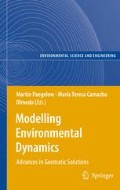Abstract
Within the last 30 years, greenhouse growth on the coast of Granada has become an environmental and territorial process of extraordinary significance, which has caused a huge transformation in the landscape and the traditional irrigated crops existing in this Mediterranean area. The creation of simulation models for generating future scenarios is focused on the evaluation of the environmental consequences of the increasing greenhouse use, mainly on non-urbanizable land according to coastal urban planning. Commonly, this land has higher environmental and heritage values. A simulation model based on cellular automata has been created, similar to those widely utilized in urban processes modelling. The agricultural use of the simulation model has followed the dynamics of urban process models of recent years, for their industrial and intensive characteristics and the significant process of diffusion and spatial contagion, with hardly taking into consideration the urban planning mechanisms.
Access this chapter
Tax calculation will be finalised at checkout
Purchases are for personal use only
Preview
Unable to display preview. Download preview PDF.
References
Aguilera F (2006) Predicción del crecimiento urbano mediante sistemas de información geográfica y modelos basados en autómatas celulares. Geofocus 6, pp 81-112
Aguilera F, Matarán A, Valenzuela LM (2005) Modelización de la dinámica paisajística: el caso de los invernaderos. VII Taller de Sistemas de Información Geográfica y Teledetección en Ecología, Alicante 24-26 de Noviembre de 2005
Barredo JI, Kasanko M, McCormick N, Lavalle C (2003) Modelling dynamic spatial processes: simulation of urban future scenarios through cellular automata. Landscape and Urban Planning 64, pp 145-160
Barredo JI, Demicheli L, Lavalle C, Kasanko M, McCormick N (2004) Modelling future urban scenarios in developing countries: an application case study in Lagos, Nigeria. Environment and Planning B: Planning and Design 32, pp 65-84
Batty M (1997) Urban Systems as Cellular Automata. Environment and Planning B: Planning and Design 24, pp 159-164
Botequilha A, Ahern J (2002) Applying landscape concepts and metrics in sustainable landscape planning. Landscape and Urban Planning 59, pp 65-93
Botequilha A, Miller J, Ahern J, McGarigal K (2006) Measuring Landscapes. A planner’s handbook. Washington, Island Press
Castilla Prados N (2004) Invernaderos de Plástico. Madrid Ed Mundi Prensa
Cheng J, Masser I (2003) Urban growth pattern modelling: a case study of Wuhan city, PR China. Landscape and Urban Planning 62, pp 199-217
Chuvieco Salinero E (2002) Teledetección ambiental: la observación de la tierra desde el espacio. Ed Ariel, Barcelona
Consejería de Agricultura y Pesca Junta de Andalucía (1991) Mapa de usos y coberturas vegetales. Sevilla
Fernández Ales R, Martín A, Ortega F, Ales EE (1992) Recent changes in landscape structure and function un a mediterranean region of SW Spain (1950-1984). Landscape Ecology 7(1), pp 3-18
Frontana González J (1984) El clima de la Costa del Sol de Granada. Aplicaciones socioeconómicas. Universidad de Granada, Granada
Pontius Jr RG, Batchu K (2003) Using the Relative Operating Characteristic to Quantify Certainty in Prediction of Location of Land Cover Change in India. Transactions in GIS 7(4), pp 467-484
Gómez Delgado M, Barredo Cano JI (2006) Sistemas de información geográfica y evaluación multicriterio. Madrid, Ed Ra-Ma
Malczewski J (1999) GIS and multicriteria decision analysis. New York, John Wiley & Sons
Meyer BC (ed) (2006) Sustainable Land Use in Intensively Used Agricultural Regions. Landscape Europe, Alterra Report No. 1338, Wageningen, pp 105-112
Matarán Ruiz A (2005) La valoración ambiental-territorial de las agriculturas de regadío en el litoral Mediterráneo: el caso de Granada. PhD Thesis, Universidad de Granada
Matarán Ruiz A, Valenzuela Montes LM (2004) The territorial model evolution of the Coast of Granada. 11th International Planning History Society Conference, Barcelona
Matarán Ruiz A, Aguilera F, Valenzuela LM (2006) Exploring new landscapes: what are the main factors affecting greenhouse expansion process in the Mediterranean coast?. International Conference on Sustainable Land Use in Intensively Used Agricultural Regions, Leipzig, Germany 20-23rd Setember 2005
McGarigal K, Marks BJ (1995) FRAGSTATS: Spatial pattern analysis program for Quantifying Landscape Structure. USDA For. Serv. Gen. Tech. Rep, PNW-351
Stefanov WL, Christensen PR (2001) Monitoring urban land cover change: An expert system approach to land cover classification of semiarid to arid urban centres. Remote Sensing of Environment 77 (2), pp 173-185
Torrens PM (2000) How cellular models of urban systems work. CASA working paper series 28
Valenzuela LM, Matarán A (2008) Environmental indicators to evaluate spatial and water planning in the coast of Granada. Land Use Policy 25 (1), pp 95-105 January 2008, Elsevier
Verburg PH, Schot P, Dijst M, Veldkamp A (2004) Land use change modelling: current practice and research priorities. Geojournal 61(4), pp 309-324
White R, Engelen G (1997) Cellular automata as the basis of integrated dynamic regional modeling. Environment and Planning B: Planning and Design 24, pp 235-246
White R, Engelen G, Uljee I (1997) The use of constrained cellular automata for high resolution modelling of urban land use dynamics. Environment and Planning B: Planning and Design 24, pp 323-343
Editor information
Editors and Affiliations
Rights and permissions
Copyright information
© 2008 Springer-Verlag Berlin Heidelberg
About this chapter
Cite this chapter
Aguilera, F.B., Matarán, A.R., Pérez, R.C., Valenzuela, L.M. (2008). Simulating greenhouse growth in urban zoning on the coast of Granada (Spain). In: Paegelow, M., Olmedo, M.T.C. (eds) Modelling Environmental Dynamics. Environmental Science and Engineering. Springer, Berlin, Heidelberg. https://doi.org/10.1007/978-3-540-68498-5_10
Download citation
DOI: https://doi.org/10.1007/978-3-540-68498-5_10
Publisher Name: Springer, Berlin, Heidelberg
Print ISBN: 978-3-540-68489-3
Online ISBN: 978-3-540-68498-5
eBook Packages: Earth and Environmental ScienceEarth and Environmental Science (R0)

